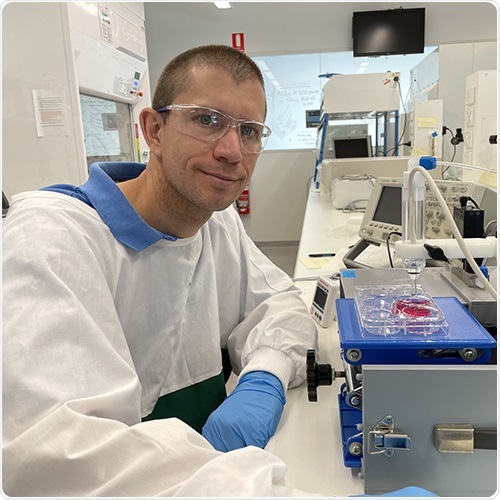Reviewed by Danielle Ellis, B.Sc.Nov 15 2021
A new formulation developed by University of South Australia scientists to treat antimicrobial-resistant bacterial infections in diabetic foot ulcers could also be used to kill the COVID-19 virus circulating in air conditioning systems.

Dr Endre Szili in his lab at UniSA's Future Industries Institute. Image Credit: University of South Australia
Enhancing cold plasma ionized gas with peracetic acid eradicates bacteria in wounds and substantially reduces SARS-CoV-2 viral loads, Australian and UK scientists claim in a paper published in Applied Physics Letters.
In an experiment to find an effective treatment for diabetic foot ulcers which are notoriously resistant to antibiotics, UniSA physicist Dr Endre Szili, in collaboration with Professor Rob Short at Lancaster University and British colleagues at the University of Bath, GAMA Healthcare and AGA Nanotech, made an unexpected discovery.
“By combining cold plasma gas with acetyl donor molecules to improve its oxidation action, we found it completely killed bacteria that are found in chronic wounds,” according to lead researcher Dr Szili.
“We then investigated whether this same technology could be effective at killing the SARS-CoV-2 virus and it appears that it is.
“We showed that we could achieve an 84 per cent reduction in viral load using plasma combined with acetyl donor molecules based on a standard dosage that is safe for human cells. However, it is highly possible with some modifications that we could eradicate it completely.”
The acetyl donor proprietary technology is owned by AGA Nanotech, a UK-based technology company focused on overcoming the increased problem of antimicrobial resistance. The solution is yet to be tested on variants of the SARS-CoV-2 virus.
Dr Szili says the technology could be used to disinfect surfaces in hospitals and other buildings, as well as dispersed through air conditioning systems.
For diabetic patients, the findings are also significant, promising an end to chronic foot wounds which affect approximately 15 per cent of the world’s 415 million diabetics.
Diabetes is the world’s fastest growing chronic health condition, costing almost USD$700 billion a year.
“Foot ulcers are a huge problem for diabetics. Antibiotics are usually the first line of treatment, but bacteria are increasingly becoming resistant to antibiotics and we need a new solution,” Dr Szili says.
Cold plasma is generally effective at targeting free swimming bacteria, but when enough bacteria colonize a wound and form a biofilm, they are more resistant to the treatment. Combining the plasma with acetyl donor molecules (ADMs) generates hydrogen peroxide and releases peracetic acid which kills resistant bacteria through a multipronged action.
The researchers compared treatment options for two different types of bacteria: Pseudomonas aeruginosa, which can cause infections in the blood, lungs, and other parts of the body after surgery; and Staphylococcus aureus, often referred to as ‘golden staph,’ which leads to blood poisoning and pneumonia and can be potentially fatal.
The technology using plasma without the ADMs killed the first bacteria but had minimal effect on golden staph. The combined treatment eradicated both bacteria.
“This is very significant for diabetic patients who have foot ulcers that are hard to heal.”
Dr Szili says the formulation could be captured in a cream or gel, an aerosol, or a wound dressing. The latter option is now being trialed with vascular surgeon Professor Rob Fitridge at the Royal Adelaide Hospital and Queen Elizabeth Hospital.
We urgently need an antibiotic-free solution to address the global escalation in antimicrobial resistance and we believe we have made an important first step with this new strategy."
Dr Endre Szili, UniSA Physicist
According to a 2016 report published by the Wellcome Collection and UK Government, by 2050 antimicrobial resistance is forecast to cause 10 million deaths a year and a potential US$100 trillion shock to the global economy.
Source:
Journal reference:
Szili, E.J., et al. (2021) On-demand cold plasma activation of acetyl donors for bacteria and virus decontamination. Applied Physics Letters. doi.org/10.1063/5.0062787.